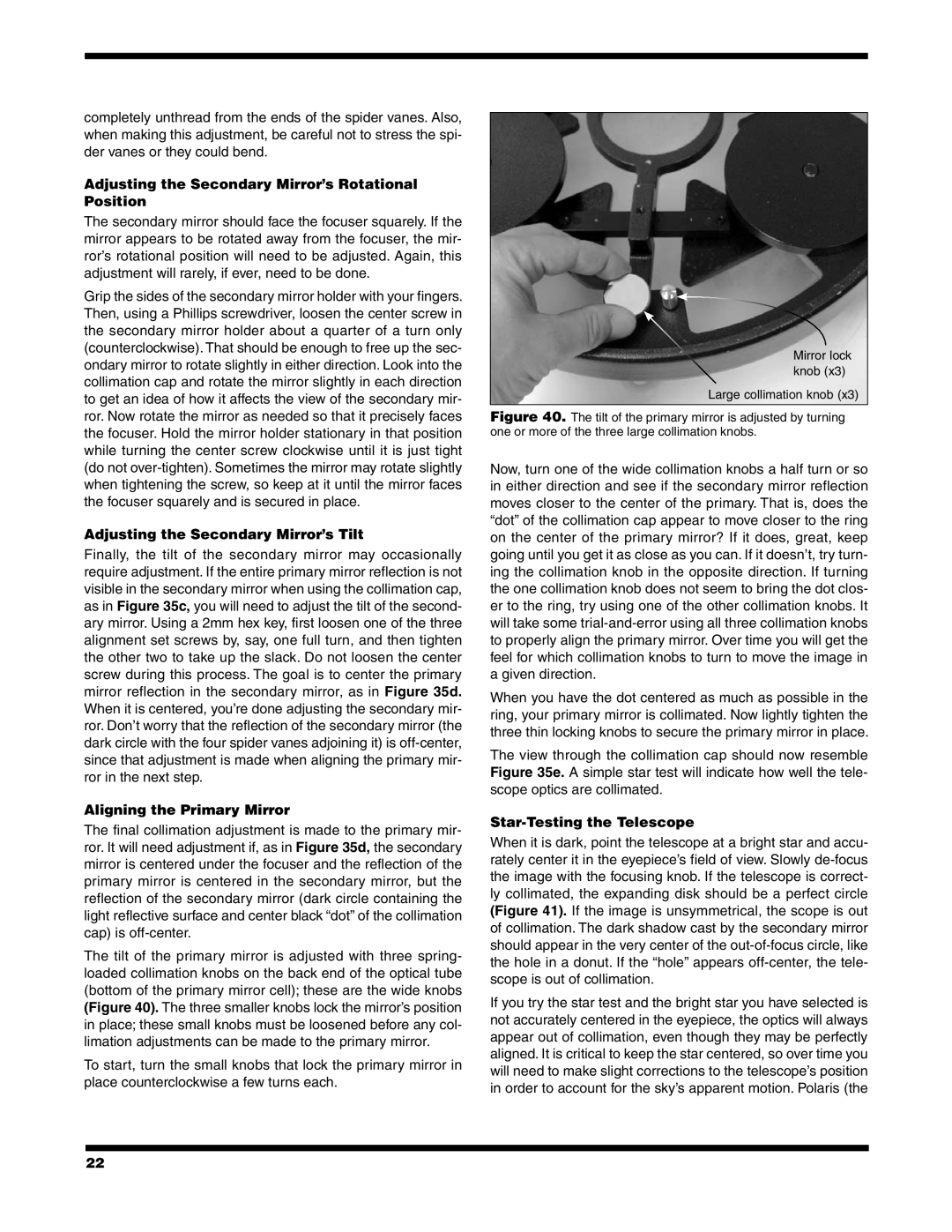
completely unthread from the ends of the spider vanes. Also, when making this adjustment, be careful not to stress the spi- der vanes or they could bend.
Adjusting the Secondary Mirror’s Rotational Position
The secondary mirror should face the focuser squarely. If the mirror appears to be rotated away from the focuser, the mir- ror’s rotational position will need to be adjusted. Again, this adjustment will rarely, if ever, need to be done.
Grip the sides of the secondary mirror holder with your fingers. Then, using a Phillips screwdriver, loosen the center screw in the secondary mirror holder about a quarter of a turn only (counterclockwise). That should be enough to free up the sec- ondary mirror to rotate slightly in either direction. Look into the collimation cap and rotate the mirror slightly in each direction to get an idea of how it affects the view of the secondary mir- ror. Now rotate the mirror as needed so that it precisely faces the focuser. Hold the mirror holder stationary in that position while turning the center screw clockwise until it is just tight (do not
Adjusting the Secondary Mirror’s Tilt
Finally, the tilt of the secondary mirror may occasionally require adjustment. If the entire primary mirror reflection is not visible in the secondary mirror when using the collimation cap, as in Figure 35c, you will need to adjust the tilt of the second- ary mirror. Using a 2mm hex key, first loosen one of the three alignment set screws by, say, one full turn, and then tighten the other two to take up the slack. Do not loosen the center screw during this process. The goal is to center the primary mirror reflection in the secondary mirror, as in Figure 35d. When it is centered, you’re done adjusting the secondary mir- ror. Don’t worry that the reflection of the secondary mirror (the dark circle with the four spider vanes adjoining it) is
Aligning the Primary Mirror
The final collimation adjustment is made to the primary mir- ror. It will need adjustment if, as in Figure 35d, the secondary mirror is centered under the focuser and the reflection of the primary mirror is centered in the secondary mirror, but the reflection of the secondary mirror (dark circle containing the light reflective surface and center black “dot” of the collimation cap) is
The tilt of the primary mirror is adjusted with three spring- loaded collimation knobs on the back end of the optical tube (bottom of the primary mirror cell); these are the wide knobs (Figure 40). The three smaller knobs lock the mirror’s position in place; these small knobs must be loosened before any col- limation adjustments can be made to the primary mirror.
To start, turn the small knobs that lock the primary mirror in place counterclockwise a few turns each.
Mirror lock knob (x3)
Large collimation knob (x3)
Figure 40. The tilt of the primary mirror is adjusted by turning one or more of the three large collimation knobs.
Now, turn one of the wide collimation knobs a half turn or so in either direction and see if the secondary mirror reflection moves closer to the center of the primary. That is, does the “dot” of the collimation cap appear to move closer to the ring on the center of the primary mirror? If it does, great, keep going until you get it as close as you can. If it doesn’t, try turn- ing the collimation knob in the opposite direction. If turning the one collimation knob does not seem to bring the dot clos- er to the ring, try using one of the other collimation knobs. It will take some
When you have the dot centered as much as possible in the ring, your primary mirror is collimated. Now lightly tighten the three thin locking knobs to secure the primary mirror in place.
The view through the collimation cap should now resemble Figure 35e. A simple star test will indicate how well the tele- scope optics are collimated.
Star-Testing the Telescope
When it is dark, point the telescope at a bright star and accu- rately center it in the eyepiece’s field of view. Slowly
If you try the star test and the bright star you have selected is not accurately centered in the eyepiece, the optics will always appear out of collimation, even though they may be perfectly aligned. It is critical to keep the star centered, so over time you will need to make slight corrections to the telescope’s position in order to account for the sky’s apparent motion. Polaris (the
22
